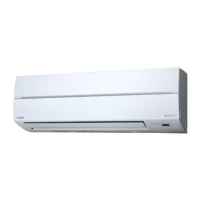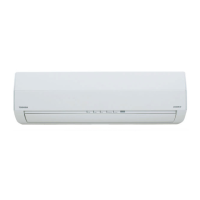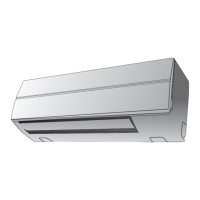Do you have a question about the Toshiba RAS-16SAV-E and is the answer not in the manual?
Covers essential safety measures for public use, installation, and general handling.
Highlights dangers of high voltage and proper electrical connection for user safety.
Details safety for new refrigerant R410A, tool requirements, and pipe material selection.
Warns against combustible gases, heat sources, modification, improper installation, and earthquake preparedness.
Provides detailed performance data, dimensions, and electrical characteristics for various models.
Emphasizes safety protocols for R410A refrigerant, pressure, and material compatibility.
Details requirements for piping materials, joints, and flare processing for R410A systems.
Lists essential and interchangeable tools for R410A refrigerant handling and installation.
Outlines the step-by-step process for safely recharging refrigerant into the system.
Discusses suitable brazing fillers, flux necessity, and types for pipe joining.
Details the brazing method to prevent oxidation and general precautions for the process.
Provides detailed diagrams and dimensions for the indoor unit and its components.
Presents diagrams illustrating the construction and dimensions of the outdoor unit.
Shows the electrical connections for specific indoor unit models.
Illustrates the electrical wiring for specific outdoor unit models.
Lists specifications for electrical parts used in the indoor unit.
Details specifications for electrical components within the outdoor unit.
Illustrates the refrigerant flow and component layout for different unit models.
Presents operational data, including pressures and temperatures, for cooling mode.
Provides operational data, including pressures and temperatures, for heating mode.
Depicts the functional blocks and communication flow for indoor unit control.
Illustrates the control system architecture for the outdoor unit and its components.
Explains the overall control system, roles of indoor/outdoor units, and signal communication.
Details basic operations, modes (Cooling, Heating, AUTO, DRY), and fan speed management.
Covers capacity, current release, temperature protection, defrost, and discharge temperature controls.
Explains ECO, Temporary, Air Purifying, Self-Cleaning, Quiet, Comfort Sleep, Timers, and Remote functions.
Covers essential safety cautions, required parts, accessories, and tools for installation.
Details the procedure for installing the indoor unit, including placement, wiring, piping, and drainage.
Outlines the process for installing the outdoor unit, covering placement, drainage, piping, and wiring.
Provides safety guidelines for inverter handling and initial steps for diagnosing issues.
Explains LED indicators, remote controller diagnosis, and troubleshooting tables for error identification.
Details checks for PC boards, sensors, and individual components for fault diagnosis.
Emphasizes critical safety warnings before proceeding with any part replacement or repair.
Provides step-by-step instructions for replacing internal parts of the indoor unit.
Guides on how to replace various components within the outdoor unit.
Shows detailed exploded diagrams and part numbers for the indoor unit components.
Provides exploded views and a list of parts for the outdoor unit.
Illustrates the layout of P.C. boards and characteristic curves for temperature sensors.
Covers essential safety measures for public use, installation, and general handling.
Highlights dangers of high voltage and proper electrical connection for user safety.
Details safety for new refrigerant R410A, tool requirements, and pipe material selection.
Warns against combustible gases, heat sources, modification, improper installation, and earthquake preparedness.
Provides detailed performance data, dimensions, and electrical characteristics for various models.
Emphasizes safety protocols for R410A refrigerant, pressure, and material compatibility.
Details requirements for piping materials, joints, and flare processing for R410A systems.
Lists essential and interchangeable tools for R410A refrigerant handling and installation.
Outlines the step-by-step process for safely recharging refrigerant into the system.
Discusses suitable brazing fillers, flux necessity, and types for pipe joining.
Details the brazing method to prevent oxidation and general precautions for the process.
Provides detailed diagrams and dimensions for the indoor unit and its components.
Presents diagrams illustrating the construction and dimensions of the outdoor unit.
Shows the electrical connections for specific indoor unit models.
Illustrates the electrical wiring for specific outdoor unit models.
Lists specifications for electrical parts used in the indoor unit.
Details specifications for electrical components within the outdoor unit.
Illustrates the refrigerant flow and component layout for different unit models.
Presents operational data, including pressures and temperatures, for cooling mode.
Provides operational data, including pressures and temperatures, for heating mode.
Depicts the functional blocks and communication flow for indoor unit control.
Illustrates the control system architecture for the outdoor unit and its components.
Explains the overall control system, roles of indoor/outdoor units, and signal communication.
Details basic operations, modes (Cooling, Heating, AUTO, DRY), and fan speed management.
Covers capacity, current release, temperature protection, defrost, and discharge temperature controls.
Explains ECO, Temporary, Air Purifying, Self-Cleaning, Quiet, Comfort Sleep, Timers, and Remote functions.
Covers essential safety cautions, required parts, accessories, and tools for installation.
Details the procedure for installing the indoor unit, including placement, wiring, piping, and drainage.
Outlines the process for installing the outdoor unit, covering placement, drainage, piping, and wiring.
Provides safety guidelines for inverter handling and initial steps for diagnosing issues.
Explains LED indicators, remote controller diagnosis, and troubleshooting tables for error identification.
Details checks for PC boards, sensors, and individual components for fault diagnosis.
Emphasizes critical safety warnings before proceeding with any part replacement or repair.
Provides step-by-step instructions for replacing internal parts of the indoor unit.
Guides on how to replace various components within the outdoor unit.
Shows detailed exploded diagrams and part numbers for the indoor unit components.
Provides exploded views and a list of parts for the outdoor unit.
Illustrates the layout of P.C. boards and characteristic curves for temperature sensors.
| Brand | Toshiba |
|---|---|
| Model | RAS-16SAV-E |
| Category | Air Conditioner |
| Language | English |











